Asus VivoBook Pro 15 OLED review (AMD, M3500QA- Vega, M3500QC- RTX 3050)
This here is the mainstream Asus VivoBook Pro 15-inch OLED series, Asus’s mid-range all-purpose laptop in the sub $1000 price niche, meant for everyday multitasking, school/work activities, and even some light gaming loads.
It’s a nice-looking and well-built design with good inputs and IO and competent hardware in this AMD variant tested here, paired with a large battery and an OLED display with punchy colors, excellent contrast, and good brightness. All these start from around 700 EUR for the base configurations over here in Europe at the time of this article.
Asus offers the VivoBook Pro 15 series in a couple of different configurations, and this here is the AMD-based Pro 15 M3500 subseries. Our test unit is the M3500QC model that pairs an AMD Ryzen 7 5800H processor with 16 GB of RAM and an Nvidia RTX 3050 dGPU, but we’ll also discuss the M3500QA variants in this article, which run on either Ryzen 5 5600H or Ryzen 7 5800H processors with Raden Vega iGPUs, as well as the top Ryzen 9 5900HX configuration, in case you’re considering any of those.
We’ll also cover the Intel-based VivoBook Pro 15 series in a separate article, but for now, let’s find out what this AMD model is all about.
Specs as reviewed – Asus VivoBook Pro 15 OLED M3500
Asus VivoBook Pro 15 M3500QC and M3500QA models
Screen
15.6 inch, FHD 1920 x 1080 px, 60 Hz, OLED, glossy, non-touch, 400-nits, Samsung SDC4161 panel
IPS anti-glare option also available
Processor
AMD Ryzen 7 5800H, 8C/16T
Video
AMD Radeon Vega – on Pro 15 M3500QA
AMD Radeon Vega + Nvidia GeForce GTX 3050 4GB (35-50W) – on Pro 15 M3500QA
Memory
16 GB DDR4-3200 (soldered), up to 16 GB
Storage
1x M.2 PCIe x4 SSD (Samsung PM9A1), single M.2 2280 slot
Connectivity
Wireless 6 (Mediatek MT7921), Bluetooth 5.0
Ports
2x USB-A 3.1 gen1, 1x USB-A 2.0, 1x USB-C gen1 with data, HDMI 1.4b, microSD card reader, audio jack
Battery
63 Wh, 120W barrel-plug charger with quick-charging
Size
360 mm or 14.19” (w) x 235 mm or 9.26” (d) x 19.9 mm or 0.78” (h)
Weight
3.7 lbs (1.68 kg)+ .45 kg (1 lbs) for the charger+cables, EU version
Extras
white backlit keyboard, HD webcam with privacy shutter, stereo bottom speakers, finger-sensor in the power button
Just to make things clear, there are two main different variants of this laptop available in stores:
- Asus VivoBook Pro 15 M3500QC – higher tier configuration with Ryzen 7 5800H/Ryzen 9 5900HX, 16 GB of RAM, and RTX 3050 graphics;
- Asus VivoBook Pro 15 M3500QA – base-level models with Ryzen 5 5600H or Ryzen 7 5800H processors and Radeon Vega graphics only.
There are also 14-inch variants of these laptops, the VivoBook Pro 14 M3400 series with AMD hardware, up to GTX 1650 graphics, and either OLED/IPS screens.
Design and construction
This VivoBook Pro 15 series is a balanced mid-tier design that checks most of the right boxes, without really excelling at any particular aspect.
It’s averagely sized, as you can tell from the bezels around the 16:9 display, and that leaves room for a full-keyboard and clickpad, as well as a spacious clickpad. It’s also not the slimmest of laptops, at 20 mm thick, which allows space inside for the internals, the thermal module, and a fair-sized battery, as well as space on the sides for a fair selection of ports.
It’s also built fairly well, with a thick aluminum piece used for lid, but plastic for the main chassis, underside, and bezels. The materials have a matte finishing and feel grippy to the touch, as well as seem quite robust and don’t flex in any noticeable way. Still, this is not a premium design by any means.
It does look alright, though, with clean aesthetics and minimal branding. Just make sure to peel off all those stickers on the armrest. Asus offers this series in two color variants, Quiet Blue – the darker one that we have here, and Cool Silver, with a silver interior, silver keys, and white lid. That latter variant does a better job at hiding smudges and finger-oil, but silver white-list keys are not my favorites, and overall I’d stick with this blue version pictured here.
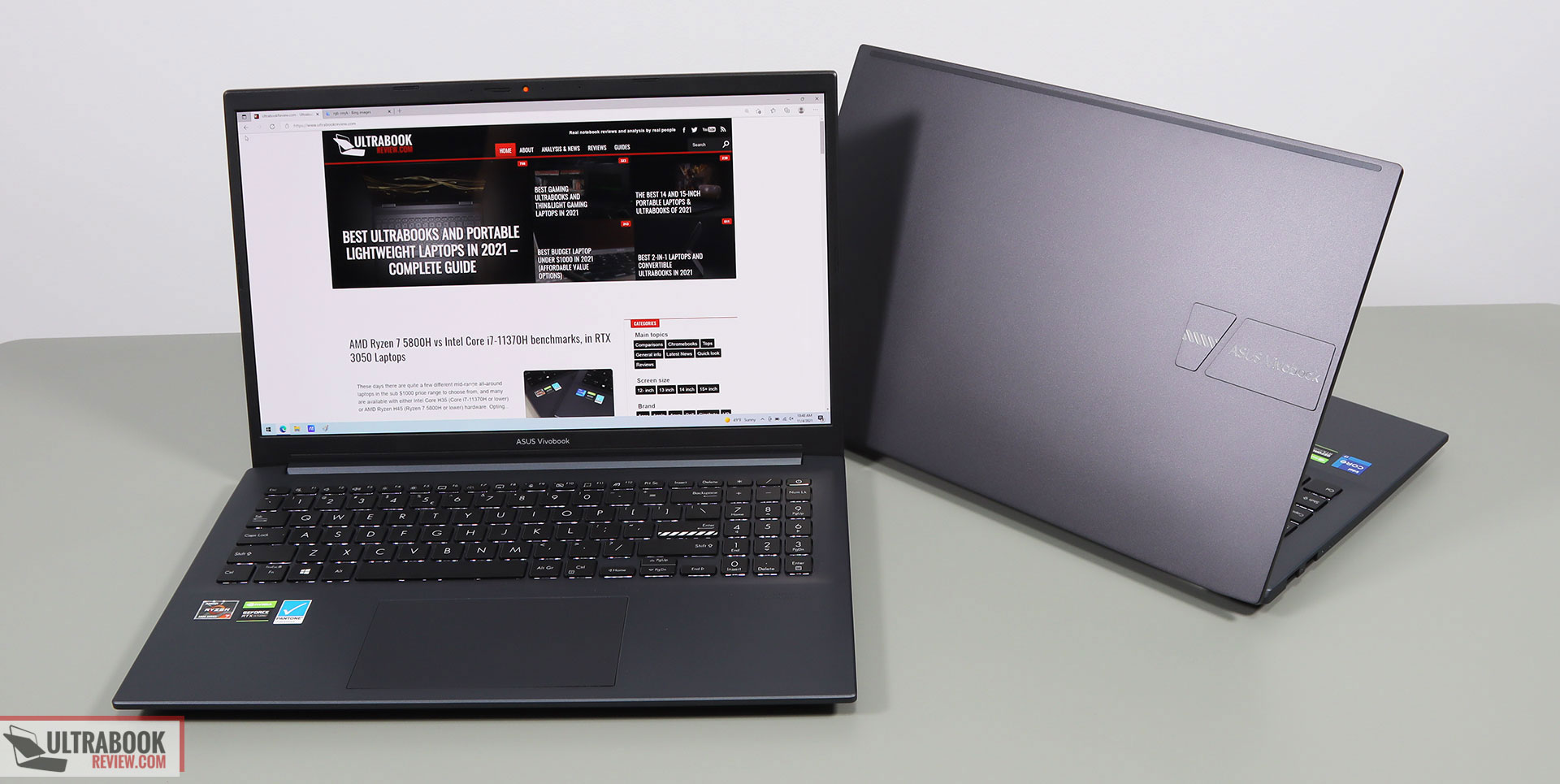
All these add up to the VivoBook Pro 15 being a fairly lightweight notebook, at 3.7 lbs/1.7 kilos in this configuration, and even less for the QA models that lack the Nvidia dGPU. As I said already, this is a well-balanced and portable everyday laptop.
Functionally, the rubber feet on the bottom ensure a good grip on the desk and the screen can be easily adjusted with a single hand. The hinges are stiff enough as well, but only allow the display to go back to about 130-degrees, which can be limiting in some cases.
I do like that Asus pushed the status LEDs out of sight on the edge and that there’s no light in the power button anymore, which instead includes a finger-sensor. I also appreciate the blunted lips and corners, which would have otherwise felt uncomfortable on the wrists on this sort of taller design.
The IO is mostly OK, but not really up-to-date with today’s expectations. There are 3x USB-A slots on this laptop, a full-size HDMI port, one USB-C, and an audio jack. However, most of these are positioned on the right side, which means cables might clutter your mouse area when connecting peripherals. Furthermore, the HDMI port is only the 1.4b and the USB-C port is gen1 and data-only, without video or charging. In comparison, the Intel variants of this laptop get a USB-C with Thunderbolt 4, video, and charging.
Finally, I have to mention that the thermal design of this laptop still places the exhausts under the hunger and under the screen, which means that some of the hot air blows into the display. However, as you’ll see in our tests down below, this design characteristic is less of an issue on this VivoBook Pro, as the hinge is specifically crafted to divert most of the air down and to the back of the laptop, away from the user and from the display.
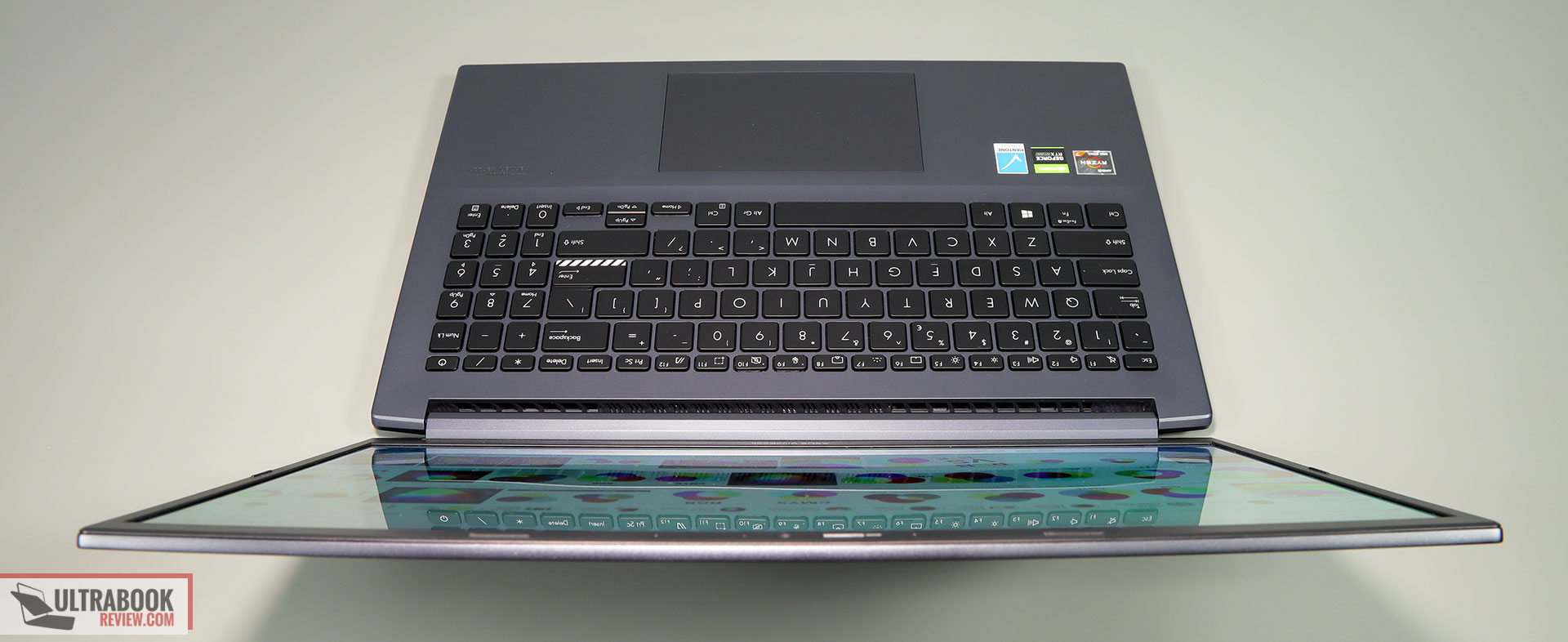
All in all, I’m OK with the design and ergonomics of this VivoBook Pro 15 series in its price range, where all the other alternatives compromise in a way or another. I do wish Asus would have offered a gen2 USB-C port here and a full-size SD card reader, I feel that those would have mattered for the target demographics of this series.
Keyboard and trackpad
The keyboard on this VivoBook Pro 15 is identical to the one on the VivoBook Pro 16X reviewed just a few weeks ago.
The layout is OK. Most keys are properly sized and spaced, but the NumPad section is made out of narrower keycaps and the arrows are squashed together. As for the Home/End/PgUp/PgDn functions, those are both binned as secondaries for the arrows keys, but also secondaries for some of the keys in the NumPad Section.
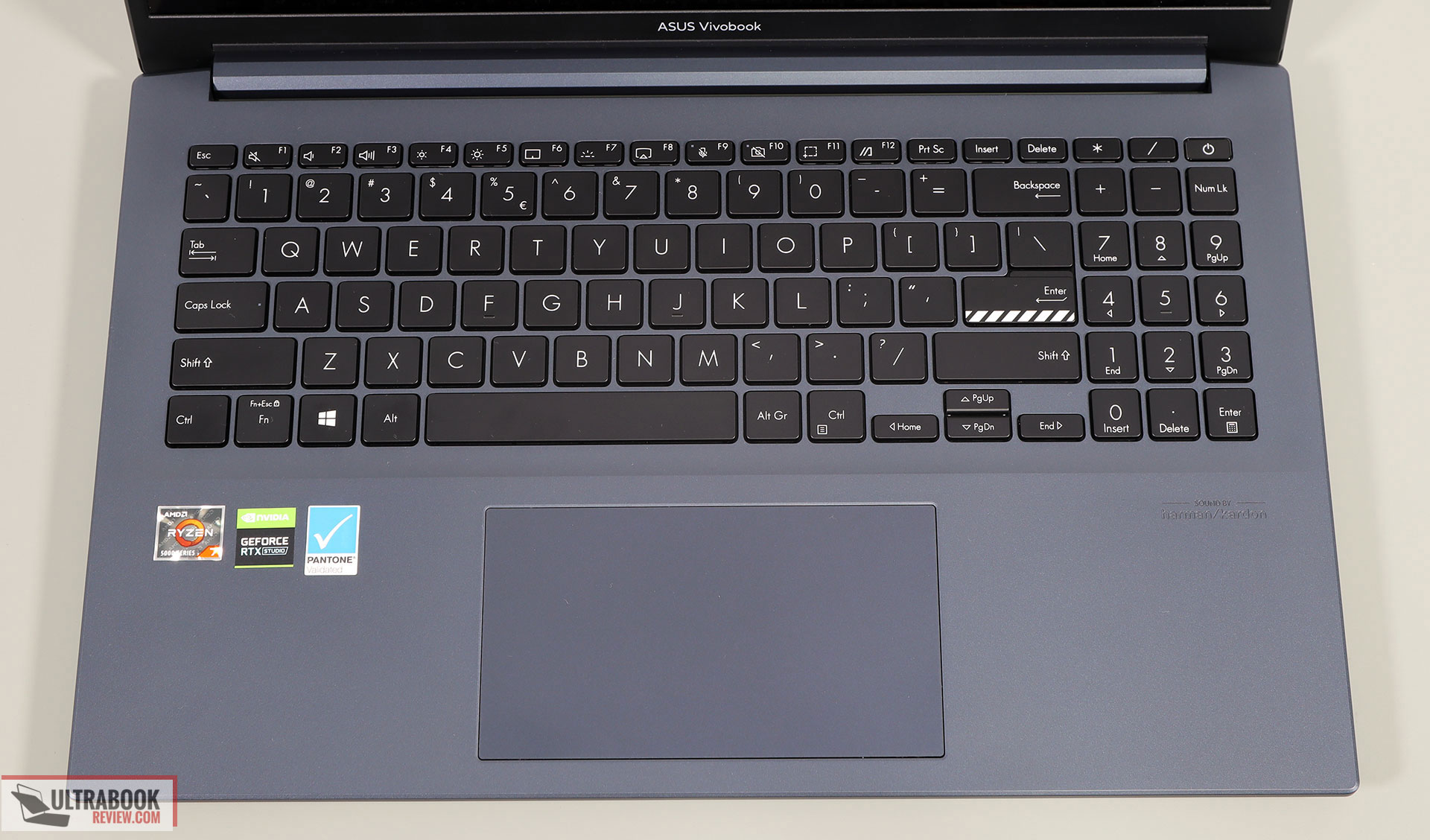
The feedback and typing experience are pretty good here, and most should find this a reliable and good typer overall. Having spent the last few weeks with this keyboard, I now think this is one of the better typers in this price class, with quick actuations, reliable feedback, and the right kind of stroke depth for my typing style.
The illumination system is white, with 3 brightness levels to choose from, a dedicated Caps Lock indicator, and the ability to re-activate the lighting by swiping your fingers over the clickpad when it times out. A fair bit of light still bleeds out from under the keycaps, though.
Since this VivoBook Pro 15 unit is the darker color variant available, it comes with these black keys that provide excellent contrast with the white illumination. However, the silver variant of this laptop gets the same silver keyboard we’ve tested on the VivoBook Pro 16X, which is still usable, but doesn’t offer the same kind of contrast and readability.
For mouse, Asus put a spacious clickpad on this VivoBook Pro 15 lineup, centered on the arm-rest. It’s made out of plastic, but still feels good to the touch and performs well with swipes, gestures, and taps.
The surface is a bit flimsy and rattles with firmer taps in the lower half, plus the physical clicks are a bit clunky, but overall this clickpad is adequate for this mid-range segment.
Finally, for biometrics, there’s a finger-sensor in the power button, but no IR camera.
Screen – FHD OLED
Asus offer two 16:9 screen options for the VivoBook Pro 15 series, a matte IPS panel, and a glossy OLED panel, both FHD resolution and non-touch.
Our configuration is the OLED panel, made by Samsung. It offers 400-nits of brightness, excellent blacks, and contrast, and 100% DCI-P3 color coverage, which means it’s a beautiful punchy display for everyday use and creative work that requires an increased color gamut.
Here’s what we got in our tests, with an X-Rite i1 Display Pro sensor:
- Panel HardwareID: Samsung SDC4161 (ATNA56YX03-0);
- Coverage: 100% sRGB, 98.1% Adobe RGB, 99.9% DCI-P3;
- Measured gamma: 2.27;
- Max brightness in the middle of the screen: 391.24 cd/m2 on power;
- Min brightness in the middle of the screen: 1.77 cd/m2 on power;
- Contrast at max brightness: 1:1;
- White point: 6400 K;
- Black on max brightness: 0 cd/m2;
- Response time: ~3 ms;
- PWM: Yes, at sub 60% brightness (per NBC).
The panel comes with a Pantone validation, and it is very well calibrated out of the box. We also haven’t noticed any significant color or luminosity variations, and since this is OLED, there’s of course no light bleeding on dark surfaces.
On the other hand, at only 400-nits of peak brightness and with a glossy finishing, this might struggle in bright environments. Furthermore, this panel used PWM at 60Hz under 60% brightness (source), the kind that those of you sensitive to flickering will notice with everyday use, and the kind I was able to distinguish myself. There’s no flickering above 60% brightness, though.
As far as gaming goes, the response time is excellent for this sort of OLED panels, but at the same time this screen is only 60 Hz and lacks and sort of Sync technology, so it’s not going to be as well suited for games as the faster IPS options available in dedicated gaming models.
And then, there’s a lot to discuss on the pros and cons of OLED panels on laptops. That’s a topic for a more specific article, but you should nonetheless research and understand the advantages (blacks, contrast, colors, low blue light emissions, etc) and the potential culprits (such as flickering, black crush, gray banding, or even burn-in to some extent) of OLED laptops before deciding whether they’re the way to go for your or not.
OLED aside, Asus also offers a more traditional FHD IPS panel option for this series, with 400 nits of brightness and only 100% sRGB color coverage. That’s mostly available with the lower tier configurations, and while not as vibrant or rich as the OLED, it is matte and could be a more worry-free option for long-term use.
Hardware and performance
Our test model is a higher-specced variation of the VivoBook Pro 15 M3500 built on an AMD Ryzen 7 5800 8C/16T processor with Radeon Vega graphics, paired with an Nvidia RTX 3050 35-50W dGPU, 16 GB of DDR4-3200 MHz of memory, and 1 TB of fast SSD storage.
What we have here is a Media Review sample provided by Asus, identical to the retail units you can find in stores. We tested it with the software available as of early-November 2021 (BIOS 301, MyAsus 3.0.29.0 app, Nvidia Studio Driver 472.69). Some aspects might change with future software tweaks.
Specs-wise, this is built on a full-power AMD Ryzen platform, with the mainstream Ryzen 7 5800H processor on our configuration. Asus implements various power profiles on this laptop, allowing the CPU to run at up to 54W sustained here. That’s not as powerful as on thicker implementations, but still very capable for a mid-range portable chassis. Ryzen 5 5600H and Ryzen 9 5900HX configurations are also available.
For the GPU, this M3500QC configuration comes with an Nvidia RTX 3050 chip, with a TGP of 35W and up to 50W with Dynamic Boost. This is the highest-end dGPU option available for this series, and configurations with Vega-graphics only are also available.
The memory is soldered on the motherboard, thus non-upgradeable. Asus offers 8 or 16 GB configurations, all with DDR4-3200 memory, so make sure you get the one that fits your needs from the get-go, as there’s no way to add more afterward.
For storage, there’s only a single M.2 2280 slot inside, so you can’t add a secondary drive when you’ll run out of space. Our model came with a very fast Samsung drive.
The SSD and WiFi chip are the only upgradeable components, and accessing them is a simple task, requiring you to remove the back panel that’s held in place by a couple of Torx screws, all clearly visible.
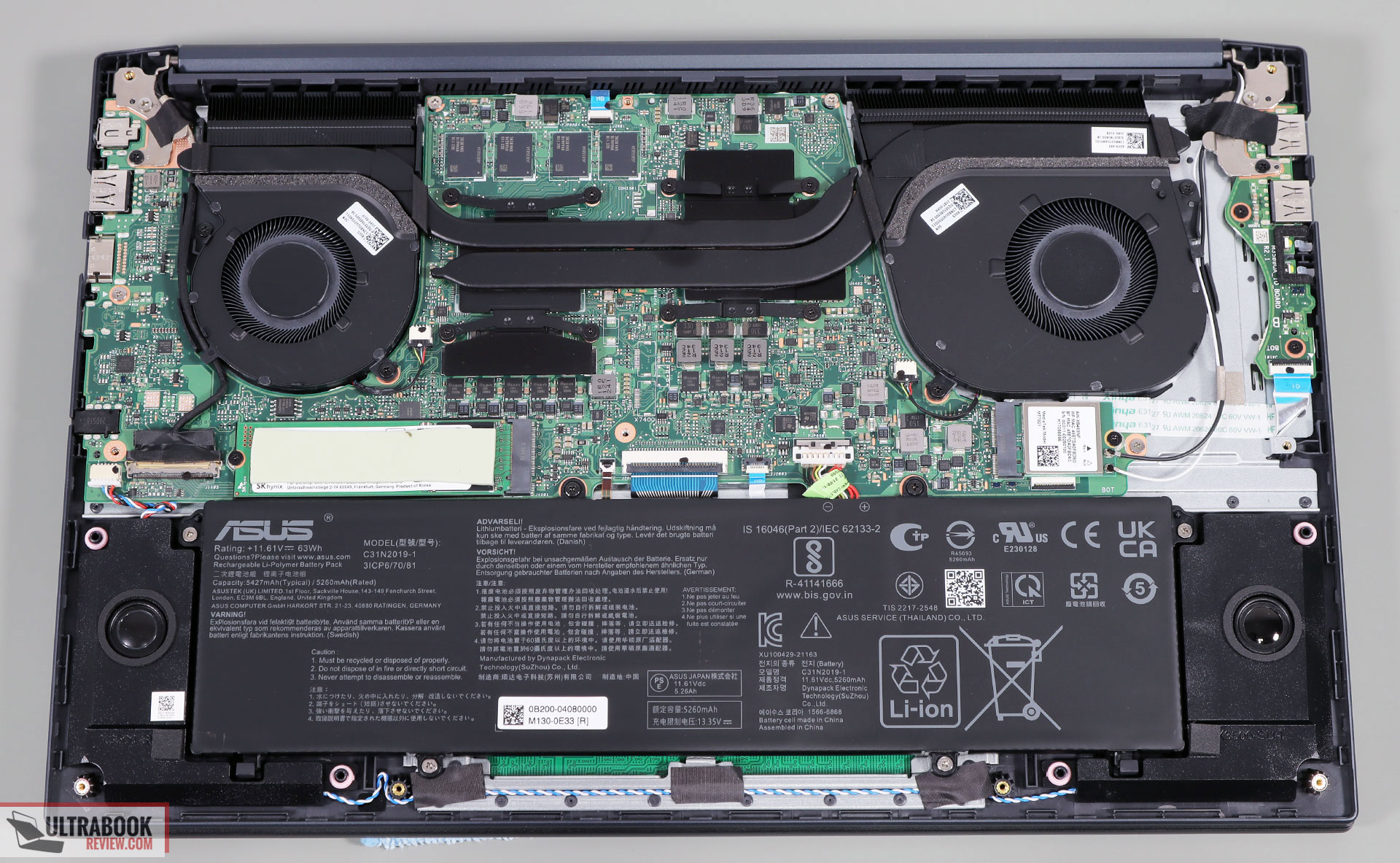
The laptop can be controlled through the MyAsus app, which offers access to power profiles, battery settings, screen profiles, and so on. There are three profiles to choose from: Performance, Standard, and Whisper mode, each impacting the amount of power allocated to the CPU and GPU, and the fans’ speeds.
I’ve kept the laptop mostly on Standard with daily use and demanding loads, and only pushed to Performance for benchmarks, demanding loads and games.
On to more demanding tasks, we start by testing the CPU’s performance by running the Cinebench R15 benchmark for 15+ times in a loop, with 2-3 seconds delay between each run.
On the Performance mode, the Ryzen 7 processor runs at 60+ W for a little bit and quickly stabilizes at ~54W of sustained power in this mode, with clock speeds of ~3.5 GHz, and temperatures of ~90 degrees Celsius. Power is the limiting factor here, as the temperatures are alright even with the fans only ramping up to 42-43 dB at head-level, quieter than on the VivoBook Pro 16X tested a few weeks ago. As it is, this Ryzen 7 5800H implementation runs at 85-90% of its maximum potential in an unlimited implementation, which is not bad at all for a mid-range design.
Switching over to the Standard mode limits the fans to around 37-38 dB. In this case, the CPU quickly settles at around 35W of sustained power, with temperatures in the high-70s. The performance also drops by about 20% from the previous profile.
Whisper mode limits the noise even more, but also limits the CPU at 25W, causing a significant decrease in performance.
Finally, the laptop runs at ~30 W of power when unplugged, on the Performance mode. All these findings are detailed in the chart and logs down below.
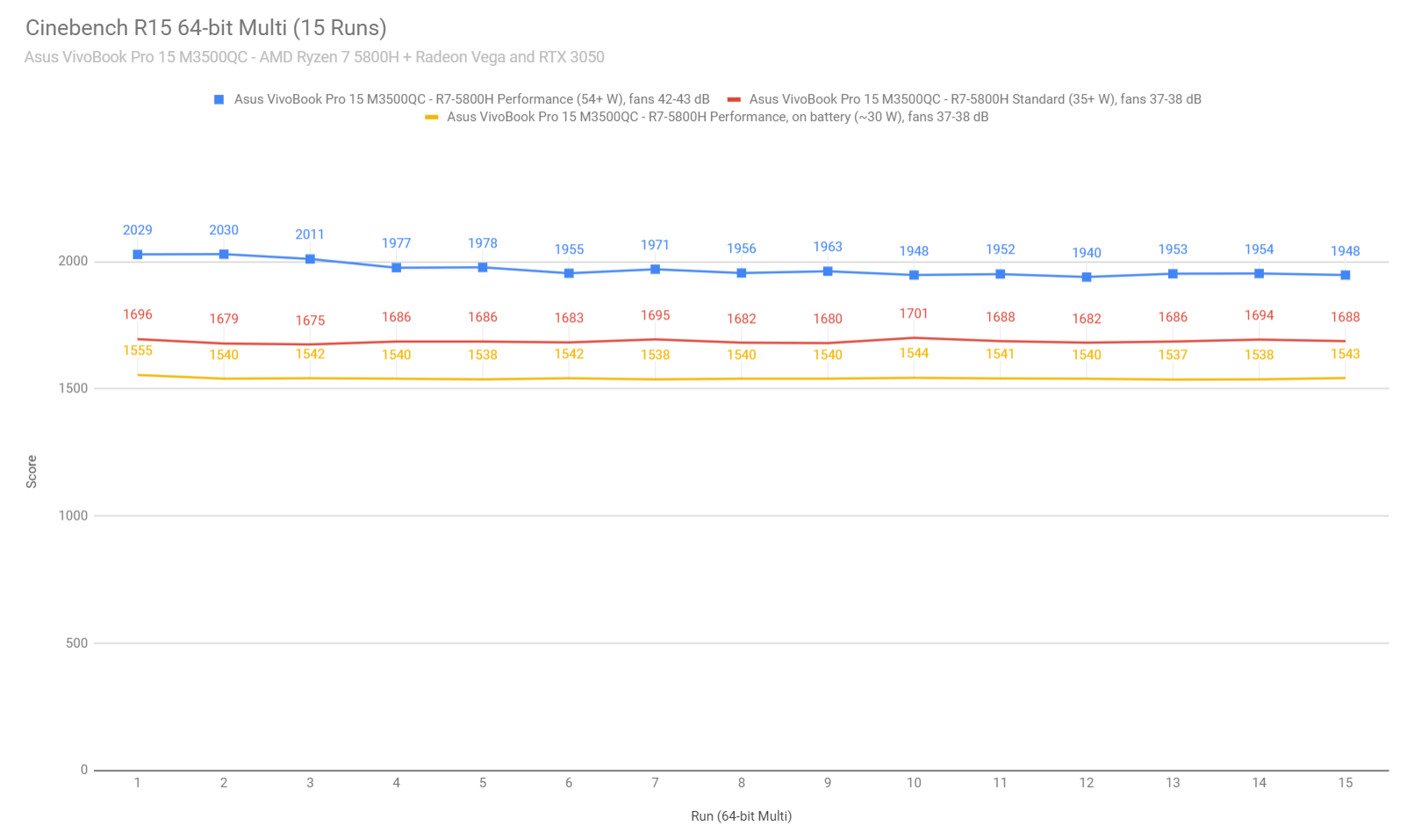
To put these in perspective, here’s how this Ryzen 7 5800H implementation fares against other 14-inch and 15-inch mid-range ultraportables in this test, both AMD or Intel. Not bad at all.
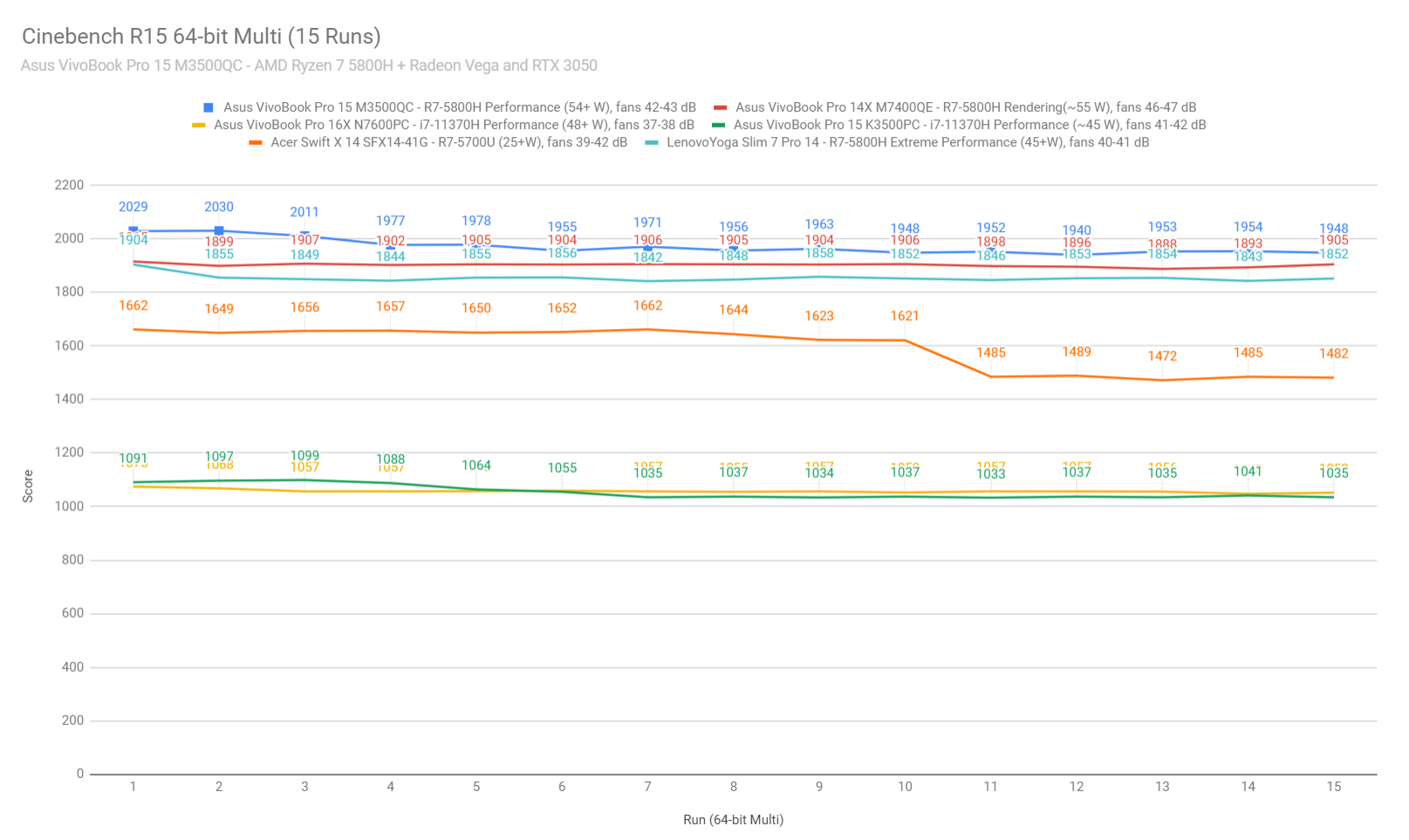
We also ran the 3DMark CPU profile test, where the Ryzen 7 5800H in this chassis once more comes within 10-15% of the beefier full-size implementations.
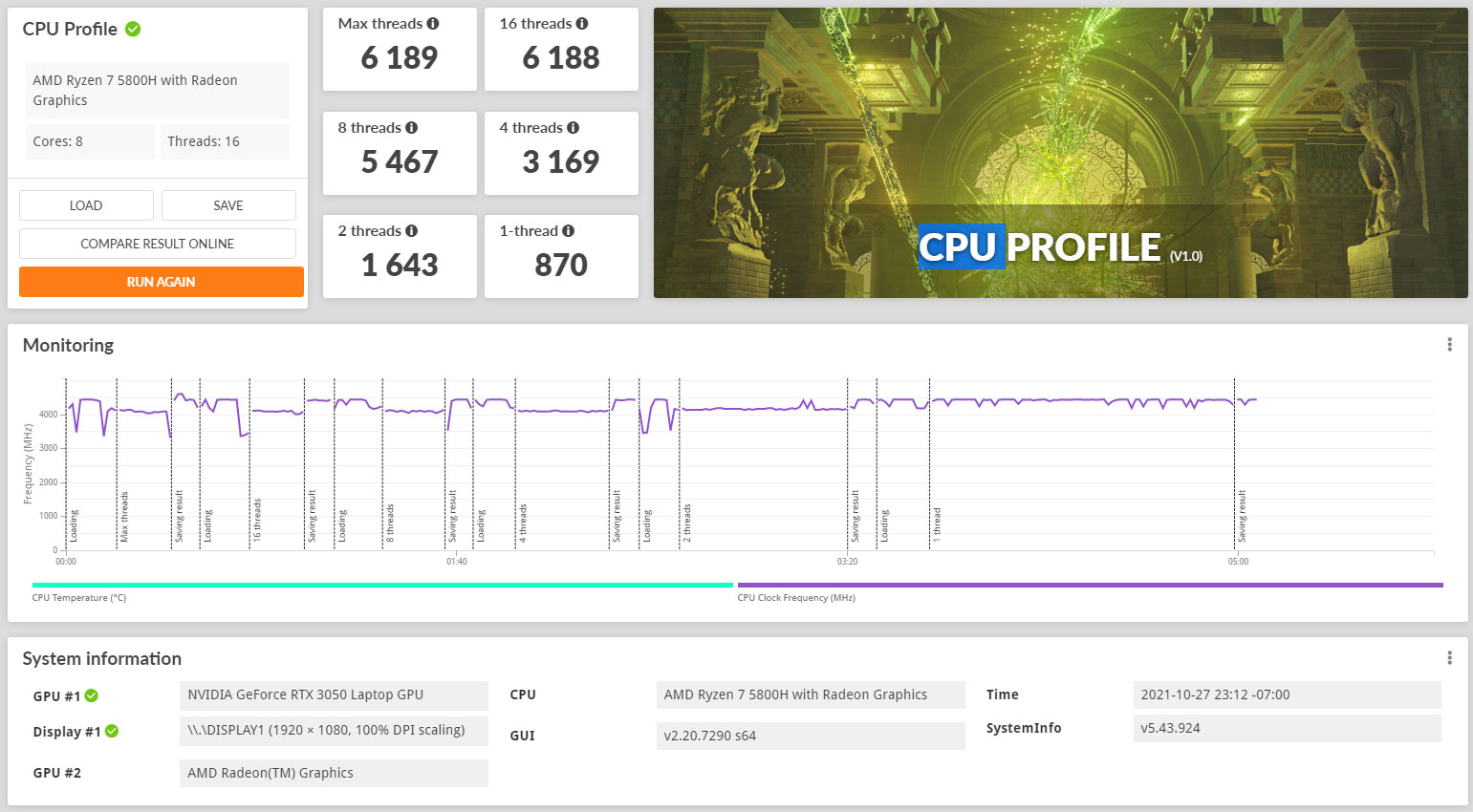
We then went ahead and further verified our findings with the more taxing Cinebench R23 loop test and the gruesome Prime 95.
We also ran our combined CPU+GPU stress tests on this notebook. 3DMark stress runs the same test for 20 times in a loop and looks for performance variation and degradation over time, and this unit passed it, which suggests there are no significant performance losses that might be caused by thermal throttling on this laptop.
Next, here are some benchmark results. We ran the entire suite of tests and benchmarks on the Performance profile at the screen’s native FHD resolution. Here’s what we got.
- 3DMark 13 – Fire Strike: 10834 (Graphics – 11780, Physics – 24109, Combined – 4462);
- 3DMark 13 – Port Royal: 417;
- 3DMark 13 – Time Spy: 4841 (Graphics – 4490, CPU – 8712);
- Uniengine Superposition – 1080p Medium: 8380;
- Uniengine Superposition – 1080p Extreme: 2618;
- Handbrake 1.3.3 (4K to 1080p encode): 36.71 average fps;
- PassMark10: Rating: 4838 (CPU mark: 21718, 3D Graphics Mark: 8797, Disk Mark: 26913);
- PCMark 10: 6285 (Essentials – 10481 , Productivity – 8906 , Digital Content Creation – 7220);
- GeekBench 5.0.1 64-bit: Single-Core: 1450, Multi-core: 7234;
- CineBench R15 (best run): CPU 1858 cb, CPU Single Core 225 cb;
- CineBench R20 (best run): CPU 4629 cb, CPU Single Core 515 cb;
- CineBench R23 (best run): CPU 11855 cb, CPU Single Core 1412 cb;
- x265 HD Benchmark 64-bit: 31.44 s.
We also ran some Workstation related loads on this Ryzen 7 + RTX 3050 configuration, on the Performance profile:
- Blender 2.93.1 – BMW Car scene- CPU Compute: 3m 35s (Performance);
- Blender 2.93.1 – BMW Car scene- GPU Compute: 1m 19s (CUDA), 50s (Optix);
- Blender 2.93.1 – Classroom scene – CPU Compute: 9m 17s (Performance);
- Blender 2.93.1 – Classroom scene – GPU Compute: 6m 2s (CUDA), 2m 48s (Optix);
- Pugetbench – Davinci Resolve: 770 points;
- Pugetbench – Adobe After Effects: 611 points;
- Pugetbench – Adobe Photoshop: 696 points;
- Pugetbench – Adobe Premiere: 454 points;
- SPECviewerf 2020 – 3DSMax: 51.19 (Performance);
- SPECviewerf 2020 – Catia: 30.75 (Performance);
- SPECviewerf 2020 – Creo: 60.49 (Performance);
- SPECviewerf 2020 – Energy: 9.8 (Performance);
- SPECviewerf 2020 – Maya: 156.73 (Performance);
- SPECviewerf 2020 – Medical: 14.83 (Performance);
- SPECviewerf 2020 – SNX: 11.48 (Performance);
- SPECviewerf 2020 – SW: 95.34 (Performance);
- V-Ray 5 Benchmark: CPU – 8180 vsamples, GPU CUDA – 456 vpaths.
On the CPU side, the Ryzen 7 5800H is a fair performer in single-core and IPS loads, and excels in the multi-core tests, scoring within 5-25% of full-size implementations of the same processor with more complex cooling. Power is the limiting factor here, as this laptop only allows the Ryzen 7 to run at 54 Wh sustained, and not higher. The gap gets wider in the longer duration loads, such as Handbrake, X265, or Blender, where the lower sustained TDP kicks in.
The GPU runs much as expected from this sort of entry-level dedicated chip.
Surprisingly, this laptop also ran rather quietly on the Performance mode, with the fans usually averaging 42-43 dB at head-level, and only occasionally ramping up to 47-48 dB for brief moments. In comparison, the same platform ran at a constant 46-47 dB in the VivoBook Pro 14X tested a while ago. You can still opt for the even quieter Standard profile, which lowers the fan noise in the 37-40 dB with the various loads.
Overall, this VivoBook Pro 15 M3500QC is a competent all-around performer in its segment.
Pro 15 M3500QA – Vega only
Some of you might consider the M3500QA variants of this laptop over the QCs. Those ditch the RTX 3050 dGPU and solely rely on the Radeon Vega integrated graphics.
For testing, we disabled the Nvidia chip on our sample and reran tests on the Vega chip, for a broad picture of what to expect from these QA configurations. Keep in mind these results might even improve on those retail QC models, as those would benefit from better-optimized drivers and software for those specific configurations.
Nonetheless, here’s what we got on this ipothetic Ryzen 7 5800H + 16 GB RAM + Vega 8 configuration:
- 3DMark 13 – Fire Strike: 3479 (Graphics – 3773, Physics – 23379, Combined – 1217);
- 3DMark 13 – Time Spy: 1391 (Graphics – 1219, CPU – 7079);
- Uniengine Superposition – 1080p Medium: 2253;
- Uniengine Superposition – 1080p Extreme: 706;
- PCMark 10: 6384 (Essentials – 10878 , Productivity – 9579 , Digital Content Creation – 6779).
- Pugetbench – Adobe Photoshop: 689 points;
- Pugetbench – Adobe Premiere: 182 points;
The CPU performance is not significantly different on this AMD-only configuration, but the GPU performance is only 30-35% of what the laptop can do with the RTX 3050 dGPU. This impacts the performance in any kind of loads that use the GPU, from digital content creation software to games.
I should also mention that Ryzen 5 5600H configurations of this laptop are also available. The 5600H is a 6C/12T and lower-clocked chip, so it will perform 5-20% slower than the Ryzen 7 in CPU loads. Careful that these configurations might only be available with 8 GB of RAM, which could also impact what the laptop can do in certain work/school projects.
At the other end, a Ryzen 9 5900HX CPU option is also available for the VivoBook Pro 15 M3500QC configurations. Expect those models to score 2-7% higher in CPU loads than the Ryzen 7 5800H variant tested here, with similar results in combined and GPU loads.
Gaming performance
While this VivoBook Pro 15 is not primarily a gaming laptop, let’s still look at how this Ryzen 7 + 16 GB RAM + 3050 configuration does in games.
For starters, we ran tests on Ultra settings on FHD resolution, with the laptop set-up on the Performance profile. We also threw in the 3050Ti configurations of the Vivobook Pro 14X and 3050 configurations of the Intel-based VivoBook Pro 15 and 16X, for comparison.
Ultra settings,
Performance profile
VivoBook Pro 15 –
R7 + 3050 35+W
FHD resolution
VivoBook Pro 15 –
i7 + 3050 35+W
FHD resolution
VivoBook Pro 16X –
i7 + 3050 35+W
FHD resolution
VivoBook Pro 14X –
R7 + 3050Ti 35+W
FHD resolution
Far Cry 5
(DX 11, Ultra Preset, SMAA)
61 fps (53 fps – 1% low)
62 fps (53 fps – 1% low)
64 fps (52 fps – 1% low)
68 fps (42 fps – 1% low)
Middle Earth: Shadow of Mordor
(DX 11, Ultra Preset)
92 fps (65 fps – 1% low)
91 fps (65 fps – 1% low)
86 fps (61 fps – 1% low)
88 fps (63 fps – 1% low)
Red Dead Redemption 2
(DX 12, Ultra Optimized, TAA)
39 fps (30 fps – 1% low)
36 fps (37 fps – 1% low)
35 fps (28 fps – 1% low)
40 fps (29 fps – 1% low)
Shadow of Tomb Raider
(DX 12, Highest Preset, TAA)
52 fps (43 fps – 1% low)
49 fps (34 fps – 1% low)
48 fps (33 fps – 1% low)
56 fps (45 fps – 1% low)
Shadow of Tomb Raider
(DX 12, Highest Preset, TAA, RTX Ultra)
24 fps (16 fps – 1% low)
20 fps (14 fps – 1% low)
19 fps (9 fps – 1% low)
24 fps (11 fps – 1% low)
The Witcher 3: Wild Hunt
(DX 11, Ultra Preset, Hairworks On 4)
53 fps (37 fps – 1% low)
55 fps (44 fps – 1% low)
60 fps (46 fps – 1% low)
63 fps (47 fps – 1% low)
- The Witcher 3 – recorded with Fraps/in-game FPS counter in campaign mode;
- Far Cry 5, Middle Earth, Tomb Raider – recorded with the included Benchmark utilities;
- Red Dead Redemption 2 Optimized profile based on these settings.
Much like in the GPU benchmarks, this VivoBook Pro 15 performs well and ends up competitive against other similar configurations in its class. Still, if you must run games on this, I’d recommend trimming down on those details.
Here’s what we got on Medium settings at FHD resolution.
Medium settings,
Performance profile
VivoBook Pro 15 –
R7 + 3050 35+W
FHD resolution
VivoBook Pro 15 –
i7 + 3050 35+W
FHD resolution
Far Cry 5
(DX 11, Normal Preset, TAA)
71 fps (48 fps – 1% low)
73 fps (60 fps – 1% low)
Middle Earth: Shadow of Mordor
(DX 11, Medium Preset)
129 fps (90 fps – 1% low)
125 fps (88 fps – 1% low)
Red Dead Redemption 2
(DX 12, Balanced – first option)
42 fps (32 fps – 1% low)
40 fps (33 fps – 1% low)
Shadow of Tomb Raider
(DX 12, Medium Preset)
69 fps (53 fps – 1% low)
68 fps (52 fps – 1% low)
The Witcher 3: Wild Hunt
(DX 11, Medium Preset, Hairworks Low)
95 fps (76 fps – 1% low)
92 fps (73 fps – 1% low)
- The Witcher 3 – recorded with Fraps/in-game FPS counter in campaign mode;
- Far Cry 5, Middle Earth, Tomb Raider – recorded with the included Benchmark utilities;
- Red Dead Redemption 2 Optimized profile based on these settings.
I also included above the Intel variant of the Pro 15, and there are almost no significant differences between the two, but it’s worth noting the AMD model wins in most games, even if by a minimal margin. I was somewhat expecting the higher-clocks and IPC of the Intel platform to push it slightly ahead in games, but that’s not the case on these devices.
On performance, this laptop runs at 42-43 dB at head-level and a combined CPU+GPU power of around 70 W. The performance is consistent and does not degrade over time, and the internal CPU/GPU temperatures are alright in most games.
However, not all titles scale with Dynamic Boost 2.0; Far Cry 5 is an example that runs the CPU at 35W and the GPU at 35W, which causes the CPU to warm up more than in other titles. That’s because the thermal design of this laptop favors the GPU side and performs best when power is shifted from the CPU to the GPU, like in our Witcher 3 and Mordor gaming tests.
Lifting up the laptop from the desk can help shed off a few degrees, allowing for better airflow into the fans. It’s not required in most titles, but it makes a noticeable difference in the unbalanced Far Cry 5.
You should also consider running games on the Standard profile on this laptop, which slightly lowers the combined platform power and the fans to 39-40 dB at head-level, for an up to 10% drop in performance.
That aside, you can game on this VivoBook Pro on battery power, as it still supplies 30W of power to the GPU in this case.
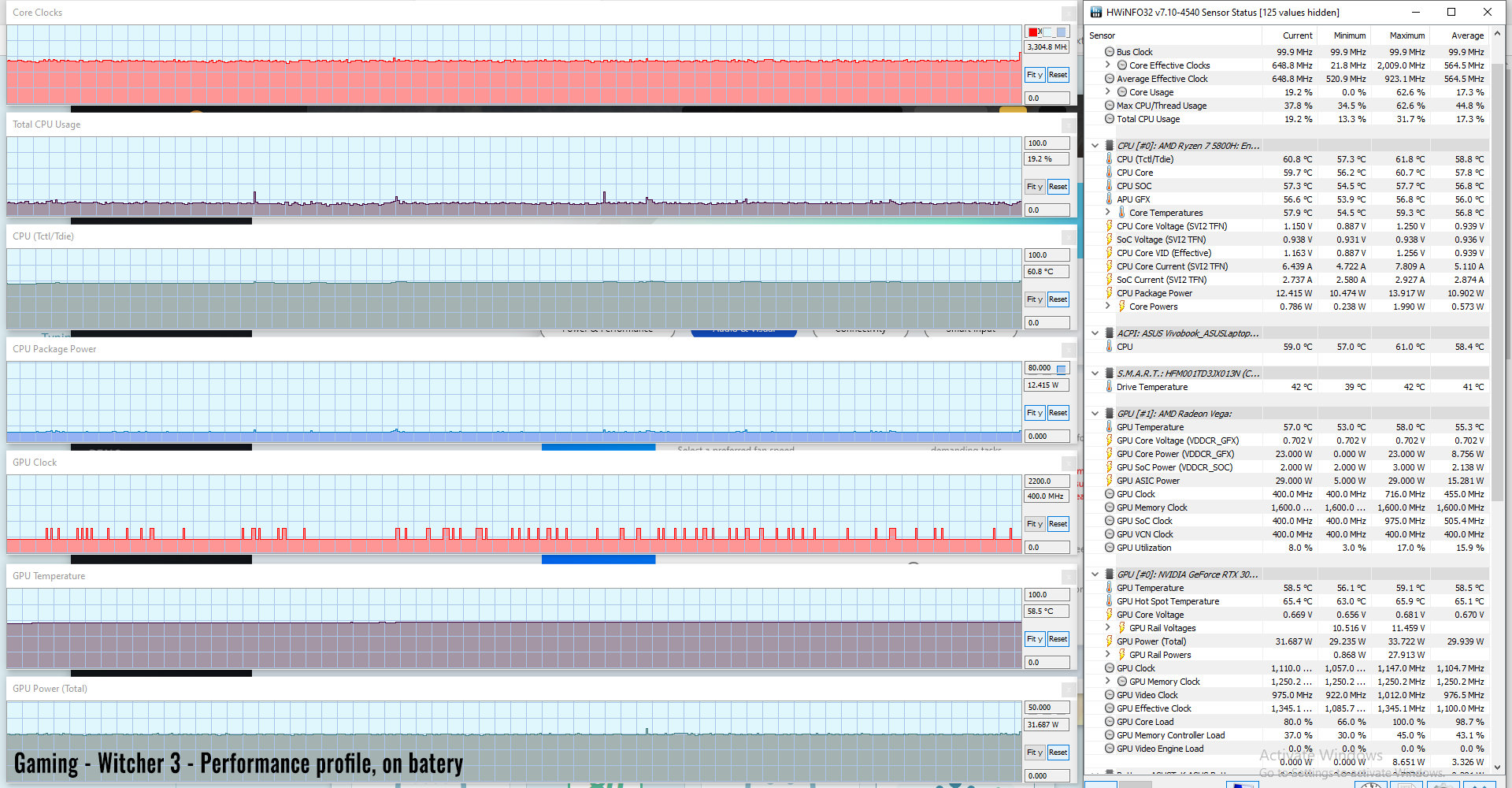
One final aspect to touch on is the gaming performance on Radeon Vega graphics, for the VivoBook Pro 15 M3500QA configurations.
Those perform well within the platform’s capabilities, as showcased in these logs down below, but don’t expect to run more than older titles at FHD resolution with low settings here. You should go through this article for a better picture of the kind of gaming experience you can expect from a mid-power Ryzen 7 5800H configuration.
Noise, Heat, Connectivity, speakers, and others
Asus went with a dual-fan dual-heatpipe thermal module here, more complex than on regular VivoBooks of the past, and identical to the system tested in the VivoBook Pro Pro 16X, with longer heatpipes and a larger fan/radiator on the GPU side, which help keep the temperatures in-check under load, as explained in the previous section.
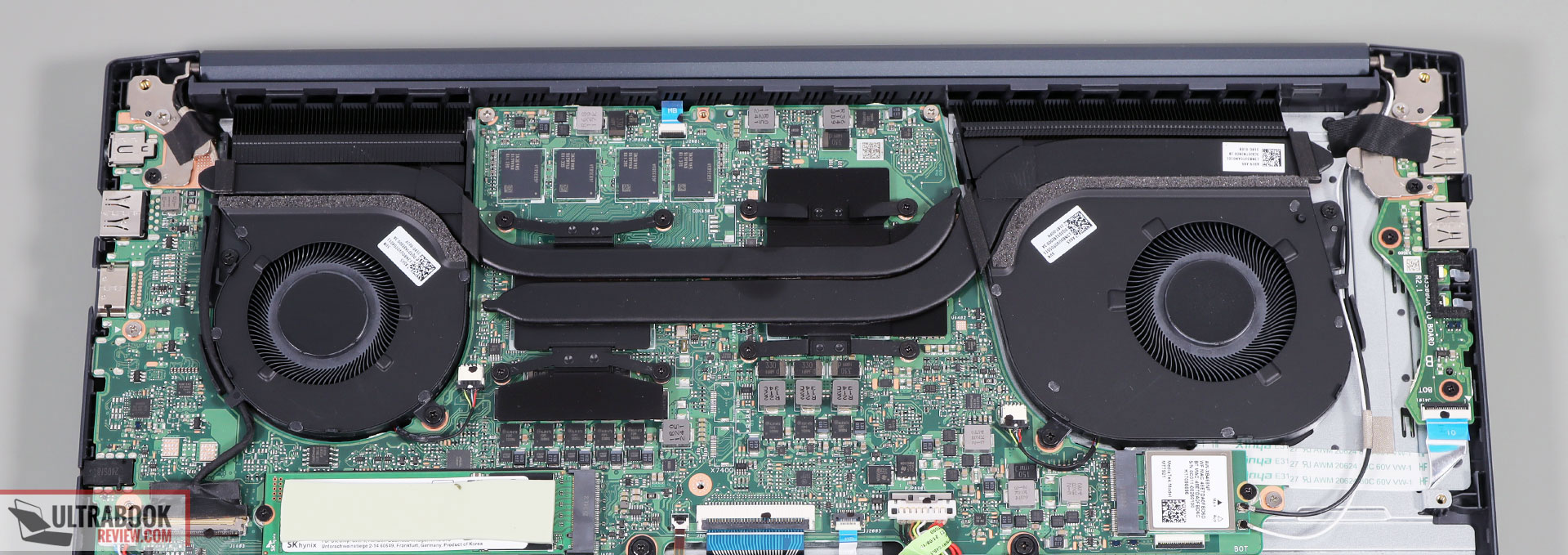
Fresh air comes in from the bottom with this design, through the open intakes over the fans and heatpipes, and the hot air is pushed out through vents hidden under the hinge. The plastic hinge is designed to split the hot air, sending most of it down and to the back and away from the user, and only some into the screen, as you can see from our thermal readings down below.
Unlike on the Pro 16X, the fans only average 42-43 dB on the Performance profile on this VivoBook Pro 15 model, which is on the quieter side for a laptop of this kind. For what is worth, though, other reviews mention up to 48 dB on Performance, but in my case, only the Intel model ramped up to 48 dB, while the AMD model averaged at around 43 dB at head-level in most cases, with the BIOS and rivers available as or early-November 2021.
The Standard profile is quieter, at 39-40 dB, with a slight toll on performance, but this might be worth considering for the much quieter experience.
The fans rest idle with light use on battery and barely kick on with daily multitasking while plugged in. I also haven’t noticed any coil whine or electronic noises on our sample, but make sure to test for them on yours.
As for the external temperatures, no complaints at all, nor with daily use, with the mostly passive cooling, or with demanding loads and games. The chassis stays under 40 degrees Celsius, with small hotspots around the radiators, to the left of the arrow keys, and over the heatpipes, on the underside. Some of the hot air is pushed into the screen, but most of it is soaked up by the plastic hinge and bezel, so the panel only reaches temperatures in the mid-30s, which will not lead to any unpleasant surprises down the road.
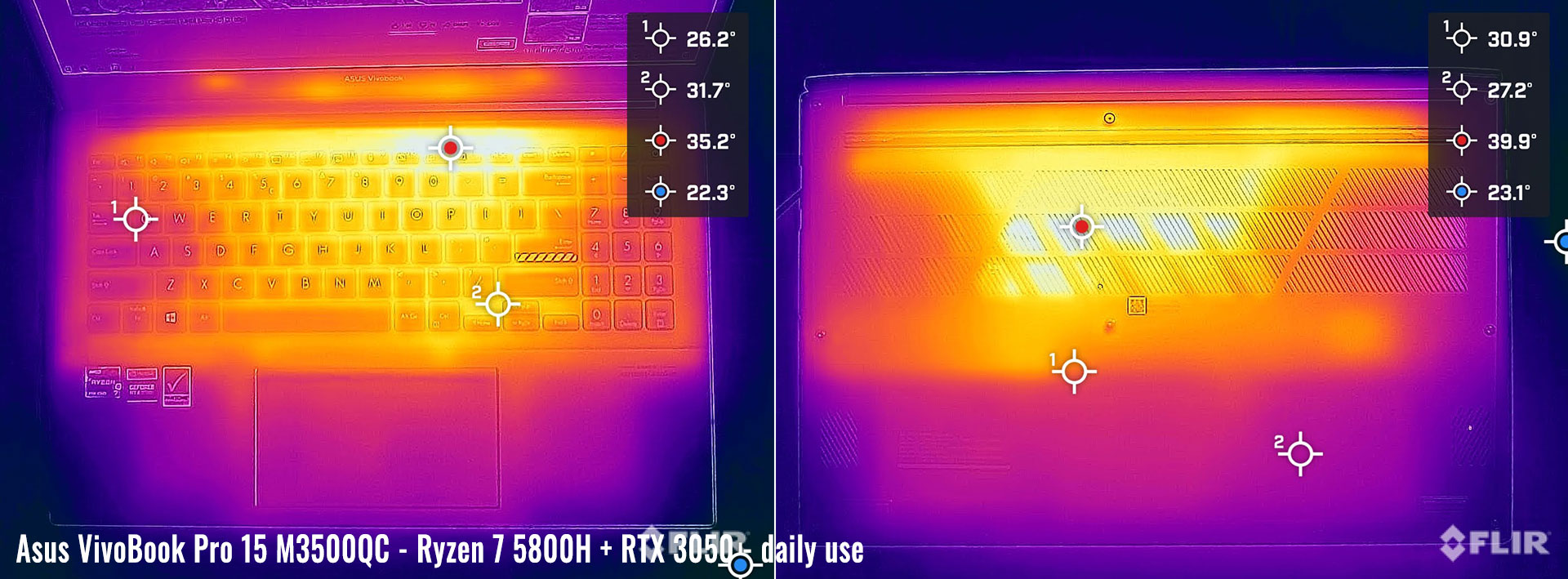

*Daily Use – Standard mode –streaming Netflix in EDGE for 30 minutes, fans at 0-35 dB
*Gaming – Performance mode – playing Far Cry 5 for 30 minutes, fans at 43-44 dB
Gaming on the Vega-only VivoBook Pro 15 M3500QA versions of this laptop results in slightly lower overall chassis temperatures, with the hottest point near the arrow keys in this case.
In all fairness, though, the QA might get a slightly more basic thermal design than the QC tested here, so take these readings with a grain of salt.
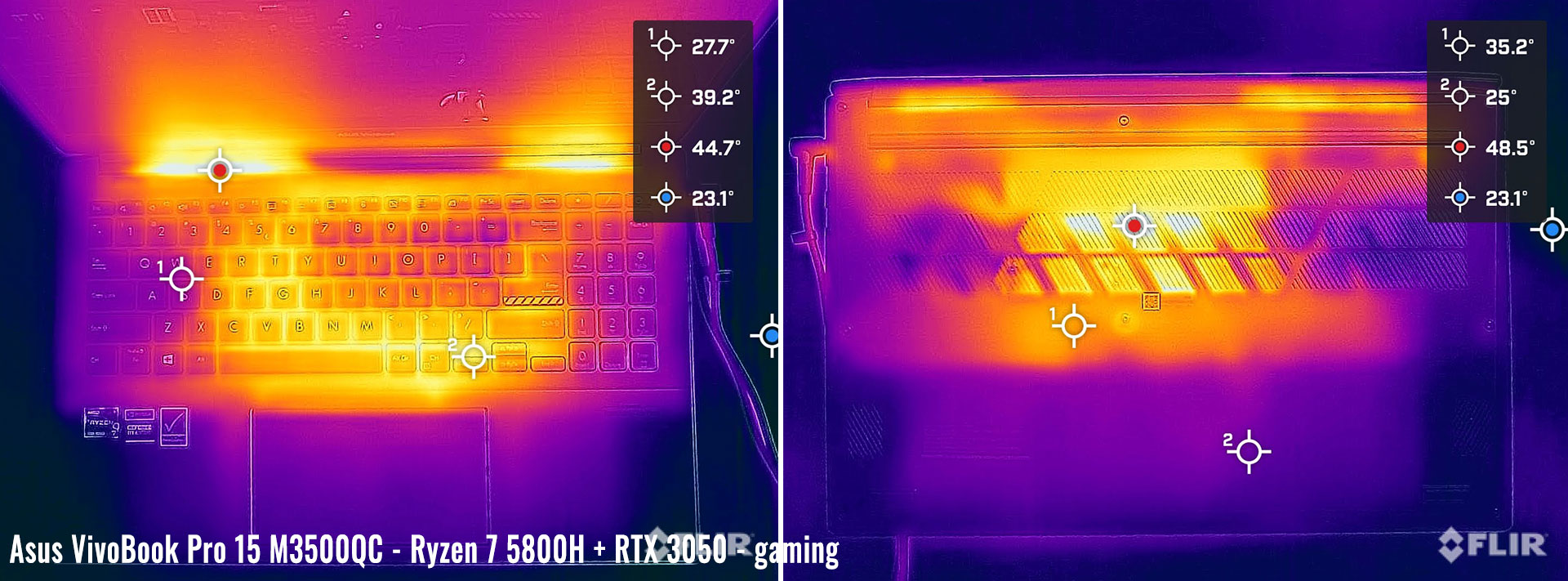
For connectivity, there’s the latest-gen WiFi 6 and Bluetooth 5 through a Mediatek module on this laptop, and not the Intel chips available on the Pro 14X/16X variants. It still performed well with our setup.
Audio is handled by a set of stereo speakers that fire through grills placed on the bottom of the laptop, on the sides. they can be easily muffled when using the laptop on the lap or on a blanket, so be careful about it.
Asus implemented some large speakers on this series, and they sure are punchy at up to 80 dB at head-level, but the quality is still only alright and still lacks in bass. Overall, the sound is perhaps a little improved over other VivoBook laptops, but I was expecting much better judging by the size of those audio chambers. Perhaps Asus can further tweak them in software somehow?
I’ll also mention that there’s an HD camera placed at the top of the screen, with a physical shutter, and it seems a little better quality than the norm, at least in fair lighting. The webcam is flanked by microphones.
Battery life
There’s a 63 Wh battery inside all the OLED versions of the VivoBook Pro 15, competitively sized for a laptop in this class. However, the non-OLED variants only come with a smaller 50 Wh battery.
Here’s what we got on our 63Wh model, with the screen’s brightness set at around 120 nits (~60 brightness).
- 10 W (~6+ h of use) – text editing in Google Drive, Standard + Better Battery Mode, screen at 60%, Wi-Fi ON;
- 6.5 W (~10 h of use) – 1080p fullscreen video on Youtube in Edge, Standard + Better Battery Mode, screen at 60%, Wi-Fi ON;
- 5.5 W (10_ h of use) – Netflix fullscreen in Edge, Standard + Better Battery Mode, screen at 60%, Wi-Fi ON;
- 11 W (~5-6 h of use) – browsing in Edge, Standard + Better Performance Mode, screen at 60%, Wi-Fi ON;
- 55 W (1+ h of use) – Gaming – Witcher 3, Performance + BeSt Performance Mode, screen at 60%, Wi-Fi ON.
The M3500QC configurations of this VivoBook Pro 15 ship with a mid-sized 120W charger, which plugs in via a standard barrel plug. USB-C charging is not possible here.
However, the Vega-only variants ship with a more compact 90W charger.
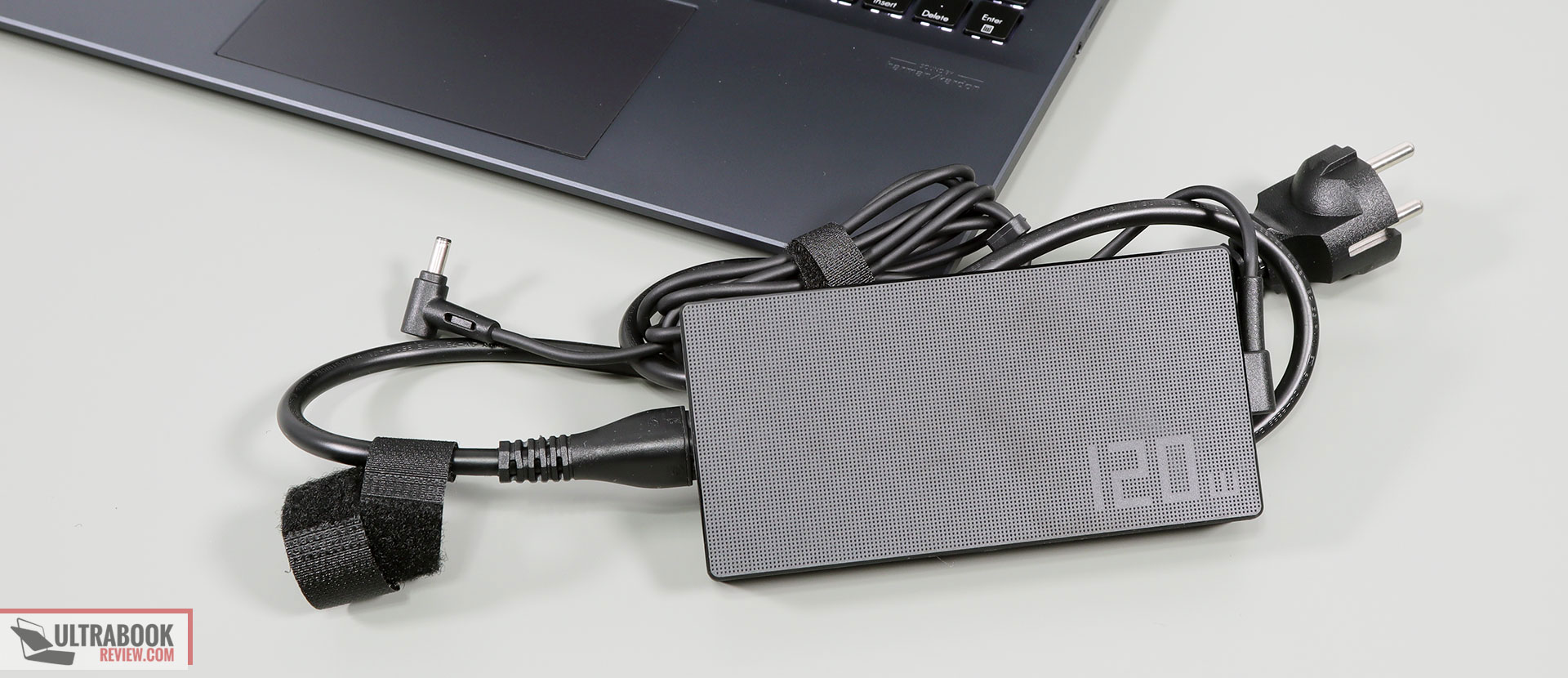
Price and availability- Asus VivoBook Pro 15
The VivoBook Pro 15 M3500 is listed in stores in some regions at the time of this article.
Over here, the tested VivoBook Pro 15 OLED M3500QC configuration with the AMD Ryzen 7 5800H + 16 GB of RAM + RTX 3050 + OLED screen of storage is available for under 1000 EUR MSRP. The same goes for around ~1100 EUR in Germany, 1000 GBP in the UK, and ~1100 USD in the US.
Follow this link for updated prices and configurations in your region.
Other configurations are available as well in some markets, with the M3500QA variants with Radeon Vega graphics only starting at around 700 EUR over here, for the Ryzen 5 5600H + 8 GB RAM versions. I’d aim for something with 16 GB of RAM, though, given how the memory is soldered and non-upgradeable.
There are also non-OLED versions of these AMD-based VivoBook Pro 15 laptops, which are identical to the one tested here, but careful that they only come with a smaller 50Wh battery.
Final thoughts- Asus VivoBook Pro 15 M3500
This VivoBook Pro 15 is arguably one of the better mid-range all-around laptops we’ve reviewed recently.
Asus put up a very competitive product here. The base-level configurations with AMD Rzyen and Vega graphics are excellent for light use and daily multitasking, while the higher-tier Ryzen models with RTX graphics can also take school/work projects and even some recent games at Medium settings.
Hardware aside, this series is also well built and good-looking, offers excellent inputs and a fair selection of ports, a big battery, and comes with a punchy and vivid OLED panel with 100 DCI-P3 color coverage, on most configurations. There are also some matte-screen IPS models to choose from, but only for the lesser configurations.
My knits are with some slightly functional ergonomics, such as the limited screen-angle and the lack of a modern USB-C connector with video and charging, as well as with the audio quality, which I had higher expectations from based on the size of the speakers inside this thing. That aside, I’d also make sure to understand the particularities of these OLED panels on laptops before jumping on one of these, just to make sure they’re right for me.
All in all, though, this is a great-value laptop and a clear recommendation in its class.
As far as the competition in the compact thin-and-light 15-inch laptop space goes, the MSI Prestige 15 comes to mind as a close rival, with a more aggressive price but poorer cooling and screen options. The HP Envy 15 is another option worth looking into, and perhaps the base-tier configuration of the XPS 15, if you’re willing to spend a little more for a premium chassis.
Furthermore, there’s also a segment of less powerful and lighter 16-inch everyday laptops you could consider, such as the Acer Swift X 16, Dell Inspiron 16, or the Lenovo IdeaPad 5 Pro 16 previously reviewed.
This wraps up our review of the Asus Vivobook Pro 15 M3500 here, and I’d love to hear your thoughts, questions, and feedback down below.
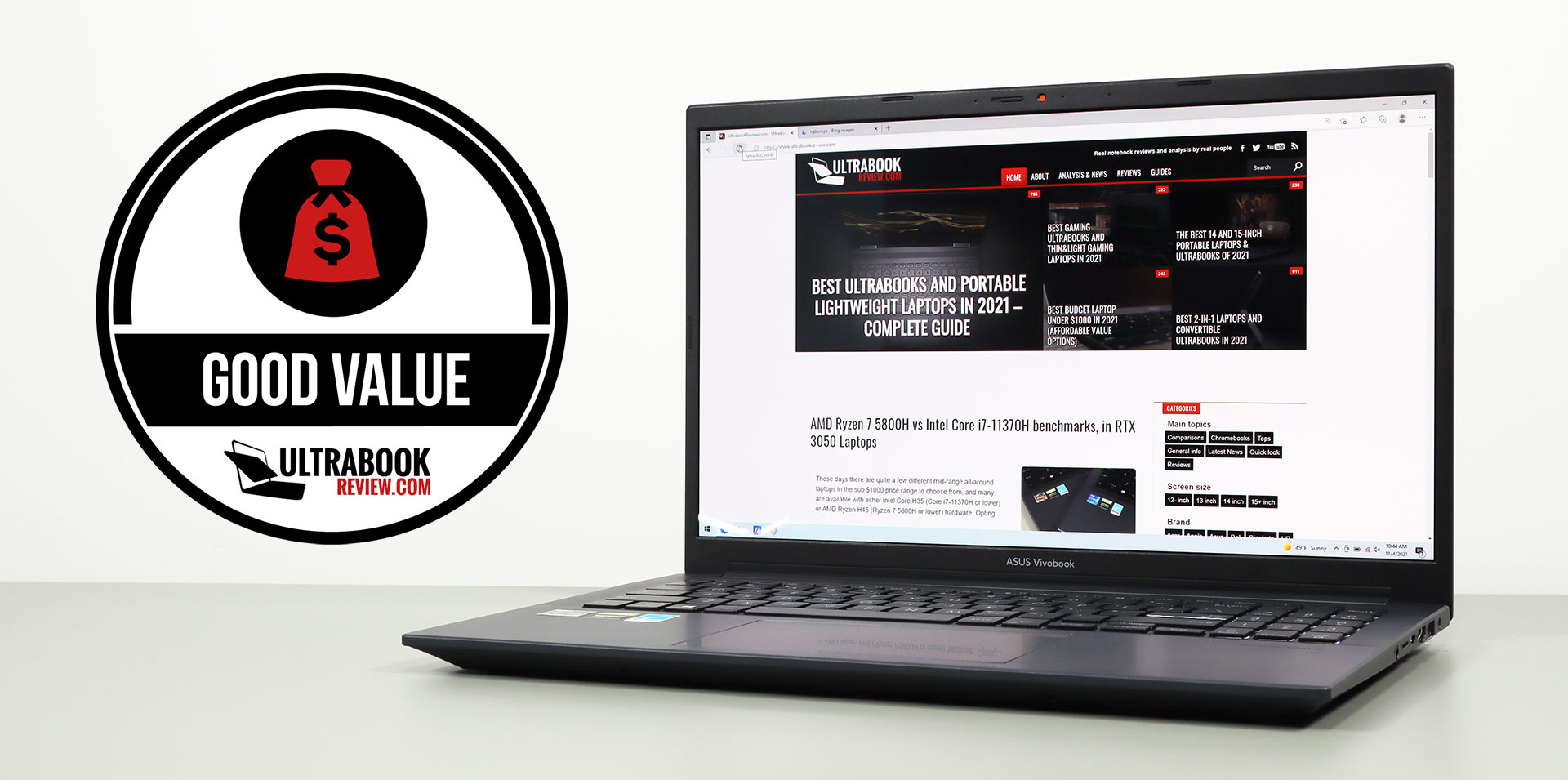
Disclaimer: Our content is reader-supported. If you buy through some of the links on our site, we may earn a commission.
Navigation: Ultrabookreview.com » 15.6 inch or larger
Our content is reader-supported. If you buy through some of the links on our site, we may earn a commission. Terms


Review by: Andrei Girbea
Andrei Girbea, Editor-in-Chief. I’ve a Bachelor’s in Computer Engineering and I’ve been covering mobile technology since the 2000s. You’ll mostly find reviews and thorough guides written by me here on the site, as well as some occasional first-impression articles.
. I’ve a Bachelor’s in Computer Engineering and I’ve been covering mobile technology since the 2000s. You’ll mostly find reviews and thorough guides written by me here on the site, as well as some occasional first-impression articles.






